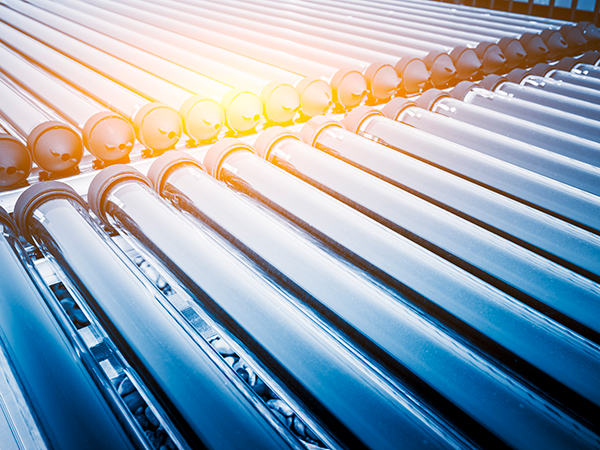
Here Comes the Sun
January 30, 2024 | By Curtis Bennett
The basics of solar thermal and why it's still a viable solution.

(Getty Images)
I don’t spend a lot of time on Facebook. I know, I know, everyone says that, but I really don’t. If I do, I mostly get caught in a spiral of mechanical videos, like CNC machines doing crazy applications and ingenious inventions.
One of my favourites is the SOLAR DEATH RAY! This guy took the front panel off of a reverse projection TV, and basically the panel is a crazy magnifying glass, like, a very crazy one!
He has the panel on a swivel because it takes absolutely no time for it to crack rocks, burn holes in metal and melt anything in its focus. I love it because it shows just how powerful the sun really is.
Solar “power” is something I have told many people is my favourite renewable resource.
In this industry we hear about two types of solar power: photovoltaic, or PV, which takes the energy from the sun and converts that to usable electricity; and solar thermal, which takes energy from the sun and “converts” it to heat. I used quotes on the “converts” for a reason. We will talk about that later.
Solar thermal has been around for a long time. It has changed and morphed over the years, but primarily it’s found in two different forms. The first is the panel type solar thermal collection. [Okay, I need to say something here before I continue: some of what I am about to say is my opinion, which is based on testing results we have done in the past.]
Panel type solar is, as it says, a solar thermal panel. Basically, a 3-ft. x 6-ft. chunk of absorption material with tiny, like ¼-in., tubes welded to the back of it. As the absorption material heats up it then transfers this heat to the tubes on the back. Those tubes have fluid running through them and voila, heated fluid.
The second style is tube type, my favourite. Why tubes you may ask? Well, the tubes are actually vacuum sealed so the ambient temperature around them does not affect the thermal transfer to the fluid inside the tube, so they are great for cold climates. [Again, this is my opinion based on data we collected over years, data that was collected in cold climates.]
Tube type solar collectors can be broken down into two subcategories. First there is an indirect version, where the solar absorption material is welded to a pipe that has fluid in it. As this fluid is heated it actually boils because it has a low boiling point. The boiling fluid heats a bulb at the top of the tube that sits in a header that has the distribution system fluid running past it. That system fluid heats up as it passes by and then goes to a storage tank.
The second type are direct tubes. In these the fluid from the system actually runs up and down inside the pipe that is welded to the absorption material. So, the fluid being heated has direct contact with the absorption material. Since we are missing one step in the heat transfer, there is a little less loss, so the direct version of these becomes slightly more efficient.
Ok, as always, clear as mud? I hope so.
Next, we move on to the two configurations for a solar thermal system: drain back and closed loop.
Let’s rewind slightly and start with the basics. At the heart of solar thermal system installations are four items: pump(s), pipes, tank(s) and controls. This does not differ between the two types of systems.
Each system takes fluid, pumps it through the solar panel where it heats up, that fluid then goes through the tank heat exchanger which heats up the water in the tank, and then the same process repeats.
The resulting hot tank of fluid can be used to heat a house, domestic hot water (DHW) or a few other applications.
The biggest difference between a drain back system and a closed loop is that one, the drain back, is not pressurized.
Ok, it’s a little more complex than that. Drain backs, or open systems, have some benefits over closed-loop systems. The biggest is there is no overheating or freezing.
At each end of the heat spectrum an open system can drain back the fluid from the panel into the tank by just stopping the fluid flow, leaving no fluid in the panels to over or under heat.
Now there are very specific piping rules to make sure of this, but they are not complex.
In a closed system you need to have a plan if you begin to overheat. This could be a second tank to dump heat into, or some heat exchanger system to get rid of some heat.
We also need glycol in our cold climate, adding another element to the closed system. Fear not, there are packaged control systems out there that include valves, pumps and controls all in one, usually called solar stations. But this article is not really about controls; it’s about solar thermal basics.
The Reality
Solar thermal is about four to five times better than PV at producing energy. Yes, it’s true, for every watt a PV system can create a solar thermal system can create four to five watts.
How can this be?
Well, think about what the sun does, it produces light in different spectrums with some producing heat under normal circumstances. In solar thermal there is no “conversion” to another property, we are taking “heat” from the sun and producing heat with it—directly.
With PV we have to convert the heat the sun makes to electricity. This electricity is also only DC power which has to be converted to usable AC power, further reducing its efficiency.
Ok, now on to the part that I love.
If solar thermal is so much more efficient than PV, why don’t we use it more?
Great question.
Complexity is the answer.
As you read above, the system side of solar thermal uses water, pumps, pipes, tanks and controls. These systems need to be installed properly or they are doomed to failure. I mean potentially catastrophic failure.
PV is a way simpler installation. That, and you can put it in fields and all you hook up is wires.
But to me, the difference in efficiency is too much to give up. It really is.
The deck is slightly stacked against solar thermal because of its relative complexity, but installed correctly you have a more efficient system, and I do still believe it has a big place in our industry—I really do.
How do we push this? I’m not sure. Well, I have some ideas …
Unfortunately, it’s subsidies that push alternative energy sources—look at the heat pump push right now.
Return on investment is everything, and solar thermal has more parts to install to make sure it runs correctly, and that extra expense hits your ROI.
In Summary
This has been a very compact explanation of solar thermal, and I’ll leave you with this image: the SOLAR DEATH RAY.
The sun is very good at creating heat, just stand outside in an all-black outfit on a sunny summer day. You overheat, but do you produce any electricity?
NO, just heat.
The goal in our industry should be using the most efficient products available. It may cost more up front, but if we want a greener planet we need to come up with innovative ways to use the most efficient solutions.
I actually think the solar death ray is a valid start. Target the ray’s heat to produce electricity, and voila the best of both worlds. Just a thought! <>

 Curtis Bennett C.E.T is product development manager with HBX Control Systems Inc. in Calgary. He formed HBX Control Systems with Tom Hermann in 2002. Its control systems are designed, engineered and manufactured in Canada to accommodate a range of hydronic heating and cooling needs. If you’d like to learn more about solar thermal controls: curtis@hbxcontrols.com
Curtis Bennett C.E.T is product development manager with HBX Control Systems Inc. in Calgary. He formed HBX Control Systems with Tom Hermann in 2002. Its control systems are designed, engineered and manufactured in Canada to accommodate a range of hydronic heating and cooling needs. If you’d like to learn more about solar thermal controls: curtis@hbxcontrols.com


